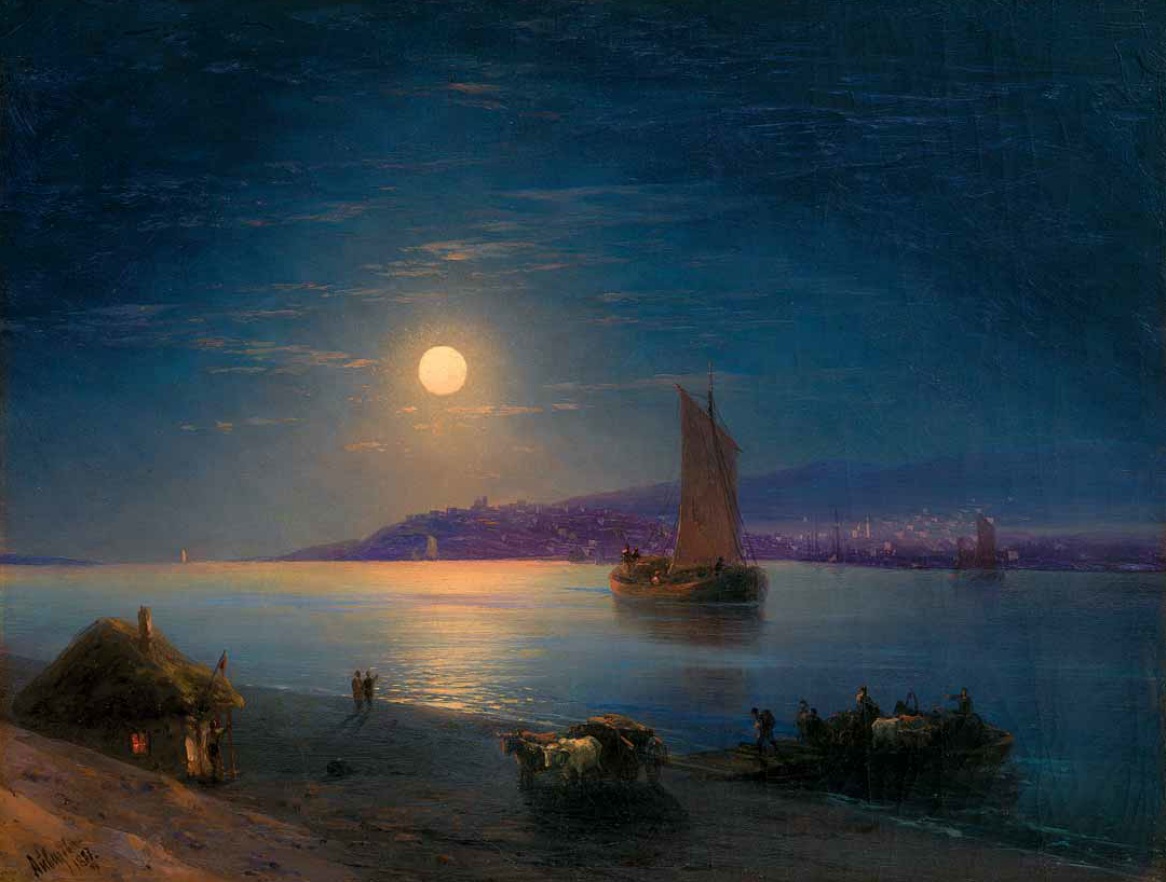MacDougall's Russian Art Auctions 1-2 Dec 2010
1 December 2010

* 320. AIVAZOVSKY, IVAN 1817-1900
Moonlit Night on the Dnieper signed and dated 1887, also further numbered "14271" on the stretcher on the reverse
Oil on canvas, 47 by 60 cm.
500,000-700,000 GBP
Authenticity has been confirmed by the expert V. Petrov.
Authenticity has been confirmed by the expert N. Ignatova.
No less than the great shipwrecks and storms, it was quiet, dreamy moonlit nights to which Aivazovsky owed his fame. The intimate work Moonlit Night on the Dnieper, now offered for auction, full of details of daily life, is among the most peaceful and serene works of this group. Without highly-coloured effects, and built on very delicate gradations of a restrained dark blue-green tonality, this work is absolutely characteristic of the 1880s in the oeuvre of this renowned painter of sea views.
In the picture Moonlit Night on the Dnieper, alongside subjects which are familiar from other landscapes by this artist — the water surface with a sailing boat, silhouettes of buildings on the opposite bank just visible in the distance, there is an everyday scene, here poeticised but prosaic by daylight, of a ferry crossing. The hilly banks, illuminated by the moon and stars, are full of pulsating life, surprising for such a late hour. At the jetty, people are awaiting the approaching sloop, with its large white sail, and the passengers are unhurriedly loading up. At the water’s edge a cart, yoked with oxen, waits patiently for its driver. A few more oxen, horses and their owners, crowded together, wait by the water. This organic co-existence of elements of genre and landscape painting, and the delicate and emotional colour choices, serve to express the harmony of the simple, natural way of life.
A single window in a little cabin by the shore shines with a warm light, a reddish point against a background of cold, spectral moonlight, transforming the familiar, real colours and forms, betraying one of the artist’s favourite devices, the contrasting combination of "two lights: the warm light of lamps in a human abode and the noble, greenish light of the night." Aivazovsky himself acknowledged that he considered such colour effects to be extremely expressive and important. "I believe," he wrote, "that my works can be distinguished, not only when compared to each other but also to many by other artists, by the potency of the lighting, and those paintings in which the main potency is the light of the sun, the moon etc., and also the waves and sea spume, must be considered the best."
Thanks to the wealth of details and detailed features, the present picture can safely be attributed to Aivazovsky’s Dnieper landscapes. It is known that the artist had immortalized this great Ukrainian river on several occasions throughout his life. In 1857, he creates the iconic work Reed on the Dnieper near Alioshka, a composition of which he subsequently paints several variations with sailing boats on the banks of the Dnieper. Not long before creating Moonlit Night on the Dnieper, Aivazovsky returns to the theme of Ukrainian landscapes, always including elements of Ukrainian genre scenes. He painted Chumaks in Little Russia, the endless Ukrainian fields with windmills, as well as views of the Dnieper with the typical barges, oxen and huts on the riverbanks.
His visual memory, supplemented by his lively imagination, allowed the artist to create in his pictures, without naturalistic accuracy, all the diversity of the emotional states of nature which he had never seen. Aivazovsky acknowledged that, "inspired by the sight of a picturesque location, with striking lighting or in stormy weather, I retain those memories for many years…" Repeating, in its most general lines, a landscape motif from his memory, but adding into it imagined genre scenes, and lighting and mood effects, Aivazovsky often shunned literal verisimilitude. According to Grigory Goldovsky, the author of many publications and catalogues about this artist, "it was his artist’s flair which allowed him to sense the relative significance — of what was crucial and what secondary — in his pictures. Crucial were the striking effect of light, the very particular rhythm. The union of light and air — this is the 'keynote', the mainstay of all his canvases. Superficial authenticity, perspective, the distribution of light, the elaboration of certain parts of the composition — these are secondary." The artist did not vary this principle throughout his life, and Moonlit Night on the Dnieper is the best corroboration of this.
Notes on symbols:
* Indicates 5% Import Duty Charge applies.
Ω Indicates 20% Import Duty Charge applies.
§ Indicates Artist's Resale Right applies.
† Indicates Standard VAT scheme applies, and the rate of 20% VAT will be charged on both hammer price and premium.